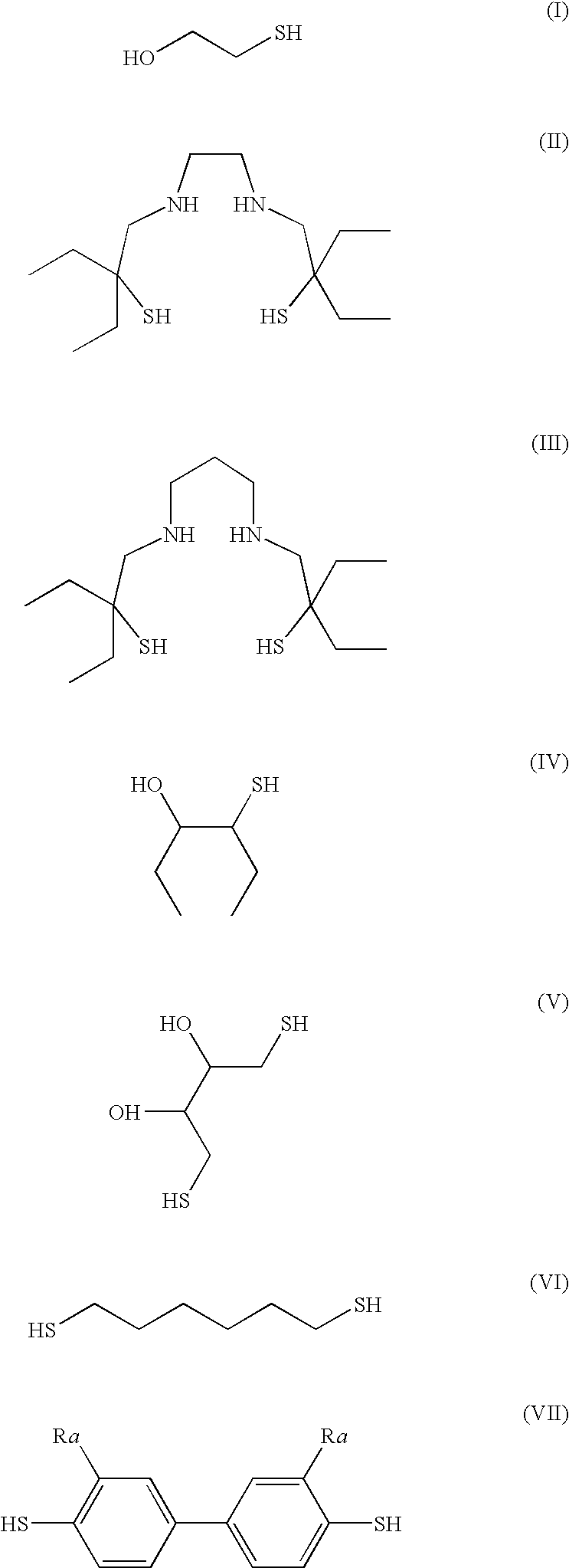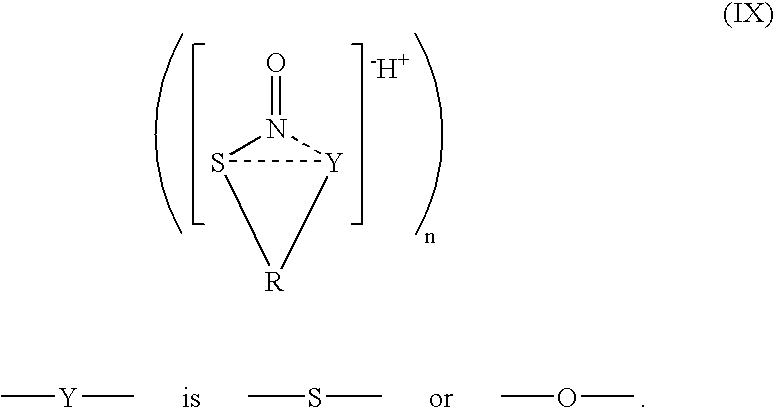Stable no-delivering compounds
a technology of no-releasing compounds and stable compounds, which is applied in the direction of prosthesis, catheters, antibacterial agents, etc., can solve the problems of unstable no-releasing compounds, the half-life of most known no-releasing compounds, and the inability to be useful commercially
- Summary
- Abstract
- Description
- Claims
- Application Information
AI Technical Summary
Benefits of technology
Problems solved by technology
Method used
Image
Examples
example 1
Preparation of Stabilized S-Nitrosylated Compounds
[0057]S-nitrosylated compounds were prepared by adding TBN to a polythiol or thioalcohol. Alternatively, S-nitrosylated compounds were prepared by adding a polythiol or thioalcohol to a solution of SNAP in DMF (0.12 M is a representative concentration). All reactions were carried out at room temperature. 0.5 equivalents of nitrosylating agent per thiol group (or per alcohol and thiol group) were used. All reactions were carried out under argon in the dark. A rapid color change to red was observed after addition of the nitrosylating agent. Stirring was continued for approximately another two to five minutes after the color change.
[0058]S-nitrosylated compounds were characterized by 15N NMR and by their UV / visible absorbance spectra. The 15N NMR spectrum of stabilized S-nitrosylated compounds showed a singlet at about 424 ppm relative to HNO3. In contrast, the 15N NMR spectrum of S-nitrosylated tertiary butyl thiol prepared according t...
example 2
Half-Lives for NO Release From Stabilized S-Nitrosylated Compounds
[0059]The half-lives for NO release from the stabilized S-nitrosylated compounds of the present invention were determined by monitoring the decrease in intensity of the absorbance maximum between 540 and 555 nanometers over time. When the nitrosylation reaction was performed neat, the uv / visible absorbance spectrum was obtained by adding several drops of the reaction mixture to a cuvette containing DMSO. When the nitrosylation was carried out in solution, the absorbance spectrum was obtained directly from the reaction mixture. Data for these plots were obtained by performing at least three absorbance scans to create a linear plot from which half-lives were determined. Kinetics runs were performed in the dark under an argon atmosphere. A Hewlett-Packard 8452A Diode Array Spectrophotometer in conjunction with HP8953 IA MS-DOS UV / VIS Operating Software was utilized to obtain kinetic data for use in half-life determinatio...
example 3
Nitrosylated 3-Mercapto-1,2-Propanediol is Bacteriostatic
[0064]Nitrosated 3-mercapto-1,2-propanediol was prepared with TBN bed in the Example 1. The nitrosylated compound was dissolved in 10 mL of deionized water (0.16 M) that had been passed through a CHELEX 100 column and bubbled with argon for 30 minutes. The resulting solution was red.
[0065]E. coli cells (pTC 190) were plated onto the culture plates and grown overnight at 40° C. The E. coli cells contained a plasmid encoding for ampicillin resistance. The solution was then sprayed onto a culture plate (LB / Amp / Glucose). After 24 hours, this plate showed the growth of a few colonies, all localized on one side of the plate.
[0066]A growth plate coated only with E. coli cells displayed a continuous lawn of growth after 24 hours. This plate was then sprayed with the nitrosylated compound solution at the 24th hour. After another 24 hours the plate contained a lawn of colonies that was approximately as dense as prior to application of t...
PUM
| Property | Measurement | Unit |
|---|---|---|
| molecular weight | aaaaa | aaaaa |
| molecular weight | aaaaa | aaaaa |
| molecular weight | aaaaa | aaaaa |
Abstract
Description
Claims
Application Information
 Login to View More
Login to View More - R&D
- Intellectual Property
- Life Sciences
- Materials
- Tech Scout
- Unparalleled Data Quality
- Higher Quality Content
- 60% Fewer Hallucinations
Browse by: Latest US Patents, China's latest patents, Technical Efficacy Thesaurus, Application Domain, Technology Topic, Popular Technical Reports.
© 2025 PatSnap. All rights reserved.Legal|Privacy policy|Modern Slavery Act Transparency Statement|Sitemap|About US| Contact US: help@patsnap.com



